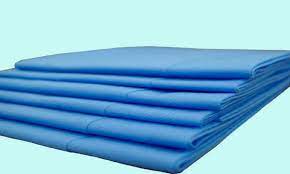Medical Industry: One Of The Major Users Of Nonwoven Fabrics
Nonwovens are called layers or web formations that are technically, thermally, or chemically joined by connecting filaments or fibers (and occasionally by perforating films). The fabric’s threads may be distributed randomly and exclusively in one direction.
Many layers may be mixed to provide the necessary mechanical qualities, like strength and elongation. Porosity may be controlled by adjusting the fiber density, size, alignment, and usage of further mechanical processes.
What is the use of non-woven fabrics in the medical industry?
Medical non-woven textiles are used in various major medical applications, such as face masks, bodysuits, sheets, caps, and filter media. They also serve as the ultimate packing material for sterilized medical supplies. Due to the rapid growth and supply demand, these Nonwoven Fabric Medical have experienced continuous upgrades and development because of their versatility, longevity, and sustainability.
Medical nonwoven textiles have successfully entered the supply chain for disinfection. It has become one of the most important components of medical supplies used in the hygiene and healthcare sectors since manufacturers also provide to several pharmacies and hospitals.
Nonwovens used externally and outside the body have a wide range of applications, including compression, wound treatment and barriers. These Nonwoven Fabric Medical materials include branded products and generics by mass market, which are well-known to most customers.
Wounded Care
The two main objectives of wound care are improving healing and avoiding infection. While some nonwoven dressings and bandages are used to wrap and protect the wound, others contact the skin directly.
Bandages and dressings, gauze, medical tapes, wadding, wraps and plasters for casting, and absorbent pads are just a few of the products and soft materials used in wound care.
Barriers
Avoiding exposure to body fluids or gases is the main purpose of barrier materials. They are frequently utilized in healthcare institutions, hospitals, and surgical centers to lessen any risk of infection, contamination, or other associated problems.
Surgical gloves, aprons, masks, gowns, pillowcases, blankets, bed sheets and furniture coverings are among the products listed in the barrier category.
Products for compression
They support, restrict, and facilitate (or limit) mobility in certain regions or portions of the body. They are made primarily by combining elastic fibers with woven or knit geometries, and they are designed to apply direct compressive forces where needed. These items include sleeves, socks, tights, wraps and support hosiery.
What is the difference between medical and regular or composite nonwoven fabrics?
Medical nonwoven fabrics majorly differ from composite nonwoven fabrics:
• Regular nonwoven fabrics are not resistant to bacteria.
• Composite non-woven materials are used to make surgical gowns and bedsheets because they have low air leakage and strong waterproof capability.
• Nonwoven Fabric Medical uses spun-bond, melt-blown, and spun-bond (SMS) techniques. It is manufactured by pressing and has dander-free, hydrophobic, antibacterial, and breathable qualities. It is utilized for the last packing of sterile materials.
Why Is Nonwoven Material a Better Option for Medical Products?
Nonwovens have continued to be the preferred material for medical product applications despite decades of advancements and improvements in the medical field. Nonwovens are used by various medical producers for goods, including surgical scrubs, bandages, medical masks, wound dressings, and other healthcare supplies.
Nonwovens provide special sanitary advantages
The frequency of infections and diseases caught up in hospitals has received a lot of focus in the healthcare industry. Due to their distinctive properties, Nonwoven Fabric Medical materials and wound dressing offer several advantages in this aspect, including:
• Regular nonwovens provide an efficient barrier against germs.
• Compared to linen, nonwovens are more effective in reducing airborne pollutants.
• Nonwoven dressings may be easily customized to meet the requirements.
• Nonwovens have a track record of reducing hazards in medical situations.
Nonwovens are created from a wide range of fibers
Medical producers can choose nonwoven fabrics with characteristics that meet the product application since numerous types of nonwoven can be created using various materials. Viscose, polypropylene, polyester, and bicomponent fiber are the most often used fibers for medical products. Nonwovens are ideal for various medical items since they may be produced in various textures, colors, and thicknesses.
Nonwovens may be environmentally beneficial
Competent producers produce unique green nonwovens appropriate for various medical devices using natural fiber compounds. Natural fiber nonwovens are not usually considered a reasonable solution to synthetic fiber nonwovens since they are sometimes considered excessively expensive. However, the medical development team has begun to build natural fiber nonwovens that offer environmental benefits while being extremely affordable.
Nonwovens are widely employed in multiple reusable medical equipment and disposable medical PPE. Nonwovens manufacture various medical products, including facemasks, blood pressure cuffs, patient gowns, orthopedic splints, braces, boots, and more. If you are looking for medical nonwoven materials, Sommers Nonwoven Solutions is the perfect place for all your medical requirements, whether you require a boot or a gown made up of nonwoven products.



Comments
Post a Comment